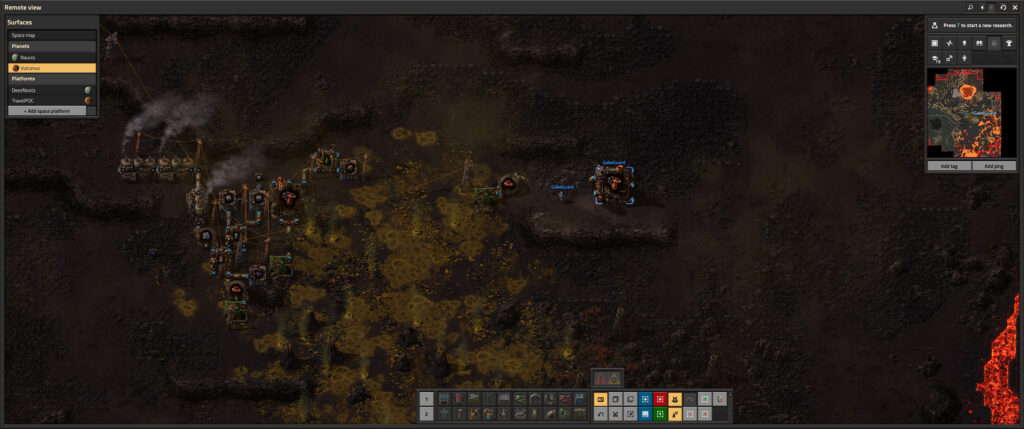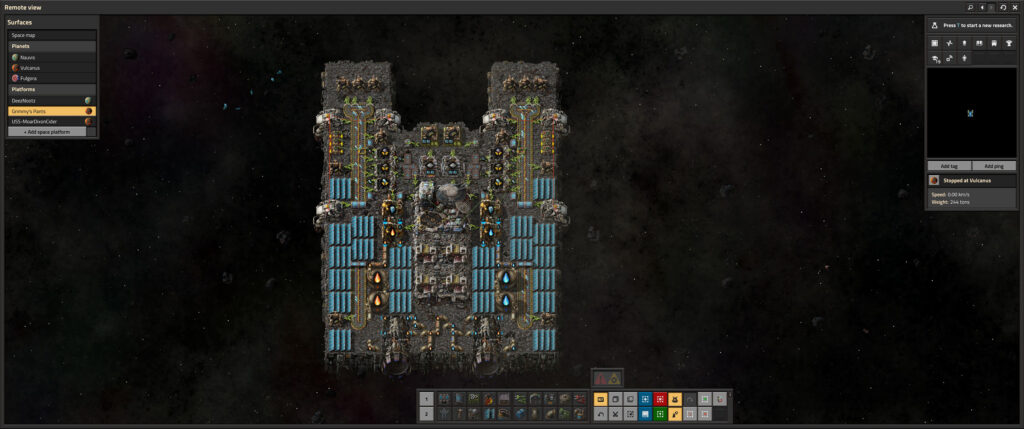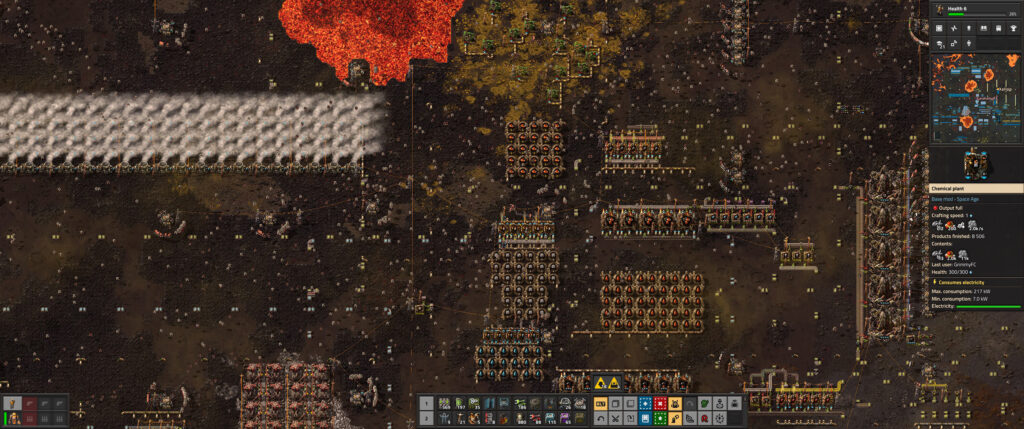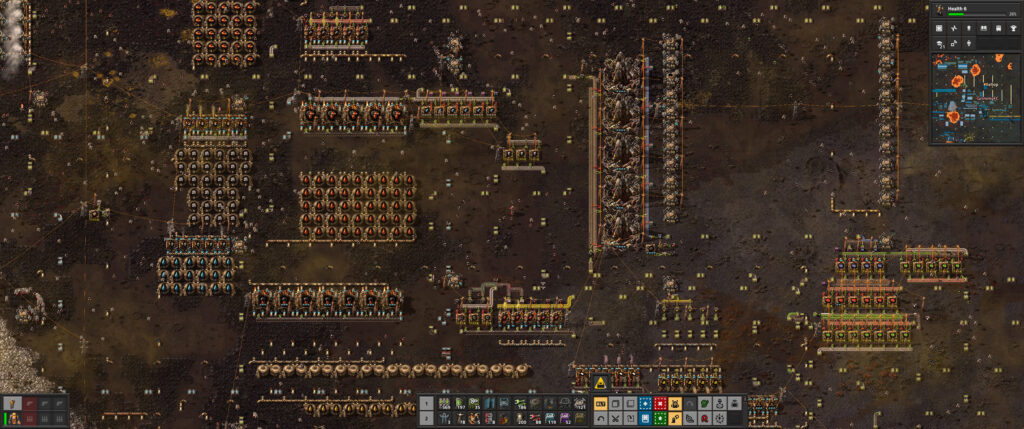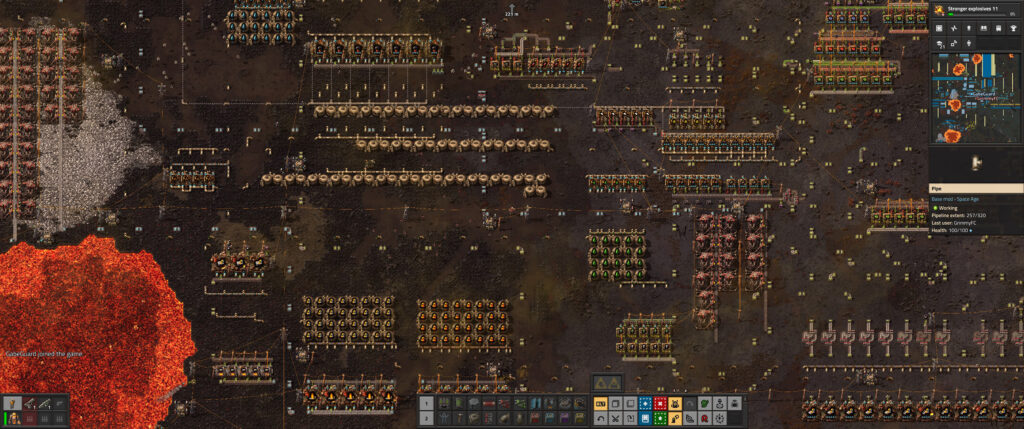Quick Verdict
Among the four of us, we spent over 300 hours finishing Factorio: Space Age from a fresh start. The expansion offers a full game’s worth of content, justifying its price tag, which matches the base game. For fans of the original Factorio, Space Age offers more than just additional planets and resources to gather; each destination introduces new challenges not found on Nauvis. Unfortunately, some of those challenges may feel gimmicky to the point of frustration. Still, Space Age builds on Factorio’s monumental foundation, taking players into the cosmos with new mechanics to explore.
The obvious thing to say here is that if you enjoyed Factorio, it’s a safe bet you’ll enjoy most of what Space Age has to offer. I’m sure there are plenty of players who enjoy the planets I found frustrating, including those who joined me in my playthrough. If you’re completely new to Factorio, however, a quick verdict won’t be enough to explain the game’s complexity and appeal.
Orbital Ambitions

In December 2016, a friend gifted me a copy of Factorio, and we spent dozens of hours playing it together. Over the years, we returned to it occasionally as the developers continued to add more content to the game. Leading up to Space Age’s release, I had around 140 hours of playtime; after Space Age, Steam shows 347 hours, if that indicates the amount of content available in the expansion. To understand the appeal of Factorio: Space Age, you need to understand what makes the base game so satisfying to play.
Factorio arguably created an entirely new genre, directly inspiring games such as Satisfactory, Mindustry, and Dyson Sphere Program. The premise may sound strange, but the goal of the game is to build a giant automated factory to turn raw materials into components or finished products, which are then used to unlock more technology. The game is part simulation, part puzzle, and a small part tower defense. The last time we played Factorio, the game finished when we launched a rocket and now that serves as a transition to the Space Age expansion. Before getting there, however, you must set up numerous manufacturing lines, bring in resources from across the starter planet, Nauvis, and automate the materials required to launch a rocket. Basically, the end game goal of the base game becomes the main thing to automate in order to expand into space.
It’s hard to explain the gameplay loop in words, but here’s the gist: you harvest resources like iron ore and stone, then use the stone to craft a furnace for smelting the iron into plates. That’s the basics, and you’ll use those fundamentals in order to setup an entire manufacturing line to provide power to an eventual factory. The base game of Factorio takes place solely on the planet Nauvis, while the Space Age expansion adds four new planets: Vulcanus, Fulgora, Gleba, and Aquilo. There’s additional content available after you conquer the four planets to roll credits.
Planetary Puzzle

The first major puzzle in Space Age is building a proper space platform to reach the other planets. These space platforms require defenses to shoot down asteroids; otherwise, they’ll destroy the platform. You’ll also have to figure out how to get fuel to the thrusters and control the speed at which you travel to balance ammo production. The game doesn’t offer much guidance on how to properly build these space platforms, making it the first tricky puzzle to decipher. This is my first major complaint with Factorio: Space Age. In order to transport the materials needed to create the space platform, you have to launch rockets into space. The problem is the one-ton weight limit, forcing dozens—sometimes hundreds—of rocket launches to build a platform capable of reaching other planets. This process can be tedious and frustrating if you’re trying to learn and experiment, especially when the space platform gets destroyed. It’s unclear why there’s such a strict capacity restriction, but many of my hours were spent waiting as I shipped materials to build a platform.
Of course you can automate this process, through a complex network of logistic robots and requester chests, but that can be fairly tedious as well. Then there’s the time it takes to build the rockets, which requires constructing multiple silos and outfitting them with speed modules if you want to be efficient. Some might argue that’s the point of the game, but the limited capacity for each rocket shipment feels overly restrictive, especially considering how easy it is for a space platform to be destroyed as you’re learning. We ultimately turned to the community to find blueprints for platforms after failing numerous times to make it to Aquilo in one piece.
Space platforms have many great concepts, especially the idea of automatically transporting cargo between planets. This is essential since certain planets have unique resources that must be transported back quickly; otherwise, they’ll spoil. They do feel divisive; some players might believe it’s not fully polished, at least not to the standard they’d expect from Factorio, while others will appreciate figuring it out themselves.
Planets Are the New Malls

Once we were able to safely travel to the other planets, we had to discover how they worked. Each planet has a unique theme—some might call it gimmicky—but what stood out to us was how differently they clicked with each of us, letting us divide and conquer. I couldn’t figure out what was happening on Gleba, especially since the resources there are time-sensitive and can spoil, so I stayed on Vulcanus, where scaling production was easier thanks to its lava resource. I imagine not everyone will find all four planets appealing, but the mechanics for handling each one are well executed. It almost feels like the difficulty of each planet reflects your personality and how you approach games like Factorio. Things definitely get trickier as you progress through the different planets, and I would caution that it’s entirely possible to soft-lock your progress. Fortunately, Factorio accounts for that possibility and automatically creates a save file whenever you embark on space travel.
The cleverness in Space Age’s design comes from how you need to use resources from each planet to your advantage. For example, as I mentioned earlier, Vulcanus is excellent for scaling production of many materials. In the screenshot above, you can see the “mall” I created, where I basically helped stockpile hundreds and thousands of items we needed across all the planets. Each planet unlocks technology that helps streamline production on other planets. It fundamentally changes how you approach automation and even resource gathering. An additional layer involves transforming your space platforms into resource providers, as destroying asteroids in space and collecting materials becomes essential for one of the planets. Each planet has a distinct biome and unique threats, offering fresh challenges never seen on Nauvis.
Power management becomes increasingly complex as you travel between planets and even in space. You have to keep your space platform powered, especially for ammo production, and that can be challenging since you can’t solely rely on solar panels. It’s all about balancing production efficiency with resource constraints, and any mistakes can have dire consequences.
Stellar Scalability

Factorio: Space Age introduces an expanded technology tree, packed with options that feel more nuanced and impactful than the last time we played. Some of these are transformative tools that change how you interact with the game, rather than basic necessities to progress. It feels very rewarding once you’re able to set up proper transportation of all the different science packs necessary to unlock the tech tree. For those who love creating complex train routes, Space Age adds elevated rails, expanding the possibilities for building the ultimate train system. I still prefer a complex robotics network to trains, but certain planets make it difficult to rely solely on logistic robots. Players now have a choice, and there are pros and cons to each option.
Another major addition in Space Age is quality on items. The good news is, it doesn’t have the impact you would initially think; meaning the game is still balanced around creating and using Normal items. Instead, you’ll get a benefit from higher-tier objects, but it never became a system where we constantly felt pressured to chase higher-quality items. It felt more like a nice bonus when it happened. Again, for players who want to build the most efficient factory in the universe, it’s a well-designed system for min-maxers.
The Great Galactic Grind

Despite all these additions, I believe the biggest benefit of Space Age is how it transforms the co-op experience in Factorio. When you’re playing with others and can only build on Nauvis, there isn’t much creativity or collaboration compared to the other planets in the game. When we embarked on our adventure with Factorio: Space Age, we started a new game, which meant spending hours on Nauvis together before traveling to the new planets. The way we worked together after that felt like an entirely new game. Suddenly, we had to communicate with each other to ship necessary items between planets. It’s difficult to explain without spoiling how each planet works, but if you can enjoy the experience with others, it’s highly recommended. Factorio: Space Age is an excellent co-op experience, vastly improving upon the base game.
Factorio was already an excellent game, and the Space Age expansion makes it even better. The list of games I’ve played for hundreds of hours isn’t very long, and it’s even more impressive that Space Age managed to do so for an entire group of us. The expansion has its frustrations, and part of its design feels somewhat unrefined compared to the rest of the game, but there’s no denying the variety and challenges it brings. If you’re looking for a fantastic game that scratches your brain, very few do it as well as Factorio: Space Age.
Factorio: Space Age official release date is October 21, 2024 on PC. This review is based on a purchased retail copy of the game on PC. While FullCleared does have affiliate partnerships, they do not influence our editorial content. We may, however, earn commissions for products purchased via affiliate links.












